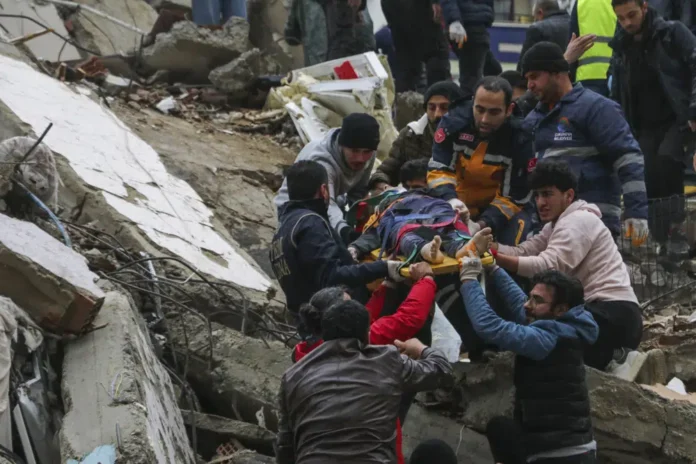Azmarin, Syria (AP) — A powerful 7.8-magnitude earthquake rocked much of Turkey and Syria early Monday morning, collapsing hundreds of buildings and killing more than 2,300 people. Hundreds of people were believed to be trapped under the rubble, and tolls were expected to rise as rescue workers searched the piles of rubble in cities and towns in the area.
On both sides of the border, on a cold, rainy and snowy night, a pre-dawn earthquake roused residents out of their sleep. The building became a pile of pancake bottoms, and new quakes, including larger aftershocks, or nearly as powerful as the first, continued to shake the area.
Rebel-held areas of Syria are home to about four million people displaced by fighting from other parts of the country. Many of them live in buildings already destroyed in previous bombings. Hundreds of families remain trapped in the rubble, the opposition emergency organization White Helmets said in a statement.
Emergency workers said strained medical facilities and hospitals quickly filled with the injured. Other facilities, including a maternity hospital, had to be evacuated, according to medical agency SAMW.
The area lies on a major fault line and is frequently shaken by earthquakes. In 1999, a similarly powerful earthquake struck northwestern Turkey, killing about 18,000 people.
The US Geological Survey measured Monday’s quake at 7.8. A few hours later, a magnitude 7.5 explosion occurred more than 100 kilometers away. An official with Turkey’s civil protection department said it was a new quake, not an aftershock, but its effects were not immediately clear. He said aftershocks were expected.
Thousands of buildings have reportedly collapsed in areas ranging from the Syrian cities of Aleppo and Hama to Diyarbakir, Turkey, more than 330 kilometers (200 miles) northeast. Turkish Vice President Fuat Oktay said a hospital had collapsed in the Mediterranean city of Iskenderun, but casualties were not immediately known.
The damage shown in photographs of affected areas is usually associated with significant loss of life, but frigid temperatures and the difficulty of working in war-torn areas complicated rescue efforts.
In Turkey, people trying to leave earthquake-hit areas caused traffic jams, preventing emergency teams from reaching the affected areas. Authorities urged residents to stay off the streets. Mosques in the area have been opened to provide shelter for those unable to return to their homes due to sub-zero temperatures. In Diyarbakir, hundreds of rescue workers and civilians line up atop a pile of rubble, handing over broken concrete, household items and other debris while searching for trapped survivors, while excavators dig through the rubble below.
Meanwhile, in Turkey, the quake damaged a historic hilltop castle in the heart of the provincial capital Gaziantep, about 33 kilometers from the epicenter. Some of the fort’s walls and guard towers were flattened, while others were badly damaged, city photos showed.
The USGS said the quake was 11 miles deep.
About 1,500 people were killed and about 8,500 injured in his 10 provinces in Turkey, according to the president of the country’s civil protection agency. According to the Ministry of Health, the death toll in government-held areas of Syria has surpassed 430, with about 1,280 injured. At least 380 people were killed and hundreds injured, according to groups operating in the rebel-held northwest of the country.






